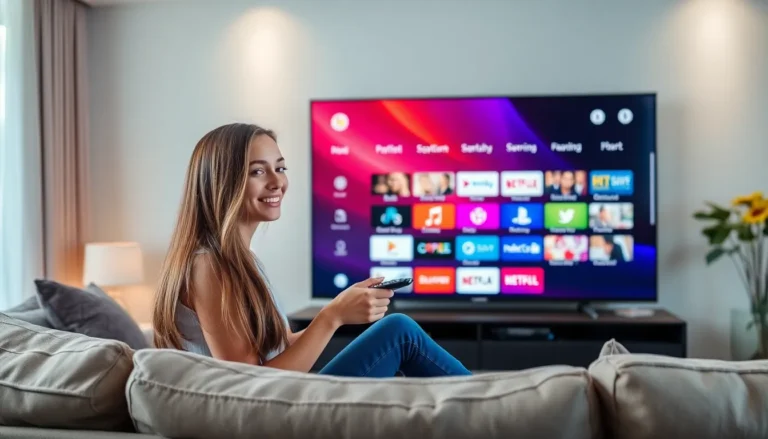In the bustling world of college life, where textbooks and late-night study sessions reign supreme, finding love can feel like searching for a needle in a haystack. Enter dating apps—your modern-day Cupid armed with algorithms instead of arrows. These platforms are designed to help students navigate the chaotic social scene while swiping right on potential partners faster than they can finish a cup of instant ramen.
Dating apps for college students aren’t just about finding a date; they’re about forging connections that could lead to long-lasting relationships or at least a fun night out. With a little charm and a solid profile pic, students can turn their campus crushes into real-life romances. So grab your phone, swipe away those awkward moments, and discover how easy it is to find someone who shares your passion for late-night pizza runs and binge-watching the latest Netflix series.
Table of Contents
ToggleOverview of Dating Apps for College Students
Dating apps serve as vital tools for college students navigating the complexities of campus life. These platforms streamline the process of meeting new people, offering functionalities that support social interaction and relationship development. Popular apps tailored for college communities focus on interests and location, ensuring users connect with peers nearby.
Many students prefer apps like Tinder, Bumble, and Hinge. Tinder emphasizes swiping features for quick matches, while Bumble highlights women initiating conversations. Hinge encourages deeper connections through prompts, fostering more meaningful exchanges. Most apps now cater to young adults, making it easier to find companionship amid busy schedules.
Safety remains a significant concern. Each app incorporates various features like photo verification and blocking options to enhance security. Users often find that these tools contribute to a more comfortable dating environment.
Moreover, dating apps frequently introduce themed events and campus features specifically designed for students. Such initiatives not only facilitate group outings but also create opportunities to meet multiple individuals, expanding social circles.
Statistics reveal that 61% of college students engage with dating apps. This trend indicates the growing acceptance of online dating among youth demographics. Users appreciate the convenience these platforms offer, allowing them to balance academics and social lives effectively.
Finding love while juggling classes and extracurriculars can seem daunting, yet dating apps prove beneficial in this landscape. With the right approach, students can develop connections that grow into enjoyable dating experiences or lasting relationships.
Popular Dating Apps for College Students

Dating apps provide college students with a convenient way to meet new people. Various platforms cater specifically to this demographic, each boasting unique features that enhance the dating experience.
App 1: Features and Benefits
Tinder allows users to swipe right for potential matches and left to pass. This simple interface appeals to college students seeking quick connections, facilitating fast interactions. Geolocation helps find matches within a specific radius, making it easy to connect with peers on or near campus. Conversations typically begin through messaging, leading to casual meetups or dates. For safety, Tinder includes features like photo verification, enhancing user security.
App 2: Features and Benefits
Bumble is distinct as it empowers women to initiate conversations. After a match, she has 24 hours to reach out, promoting proactive engagement. The app’s focus on respect and safety resonates with many students. Location-based matching ensures users connect with nearby individuals, perfect for spontaneous plans. Bumble also features Bumble BFF and Bumble Bizz, allowing users to find friends or network professionally, enriching the college experience beyond dating.
App 3: Features and Benefits
Hinge promotes meaningful relationships by encouraging users to engage with profile prompts. It prioritizes deep connections over casual flings, appealing to college students seeking authenticity. Besides the swiping mechanism, users can like specific parts of a profile, fostering conversation starters. In addition to location-based matching, Hinge has safety measures like identity verification. The app’s design promotes a user-friendly experience that resonates with those interested in serious commitments.
How to Choose the Right Dating App
Selecting the right dating app hinges on several important factors.
Factors to Consider
Prioritizing user demographics is essential. Some apps cater specifically to students, while others target a broader audience. Evaluating features like swipe functionality or detailed profiles can impact the experience. Different platforms accommodate various relationship styles, from casual dating to serious commitments. Considering location features ensures connections stay relevant. Lastly, assessing safety measures such as photo verification and reporting tools enhances user confidence.
Tips for College Students
Utilizing campus-specific apps can yield better results. Connecting with others in similar academic environments fosters a sense of community. Engaging regularly with the app increases visibility and chances of meeting someone. Crafting an intriguing profile is vital; highlight interests, hobbies, or favorite classes. Taking advantage of themed events organized through platforms allows for social interaction in a group setting. Maintaining openness about intentions helps establish clear expectations.
Safety Tips for Using Dating Apps
Safety remains a top priority for college students engaging with dating apps. Students must take certain steps to protect themselves while connecting with potential partners.
Protecting Your Privacy
Protecting personal information is crucial. Avoid sharing sensitive details like your home address, phone number, or financial information before establishing trust. Use app-specific messaging features instead of personal texts to maintain boundaries. Review privacy settings to control who can see your profile. Familiarize yourself with app safety features, including blocks and report options, which help manage unwanted contact. Always consider the visibility of your profile to ensure you engage only with those you feel comfortable with. Taking these precautions reduces risks associated with online interactions.
Meeting in Person
Meeting a match in person requires careful planning. Choose a public location for the first date, such as a café or campus event, to maintain safety. Inform a friend about your plans, sharing details like time and location. Bring your phone charged and keep it accessible for emergencies. Trust your instincts during the meeting; if something feels off, it’s always okay to leave. Arrange your own transportation to prevent being reliant on the other person. These strategies enhance safety and create a more relaxed environment to enjoy the date.
Navigating the dating scene in college doesn’t have to feel overwhelming. With the right dating apps, students can easily connect with others who share their interests and goals. These platforms not only simplify the process of meeting new people but also offer a safe environment for exploring potential relationships.
By leveraging features tailored for young adults, students can enhance their social lives while prioritizing safety. Embracing the world of online dating can lead to meaningful connections and unforgettable experiences. As college life becomes increasingly busy, dating apps stand out as valuable tools for fostering romance and friendship in a fast-paced environment.







